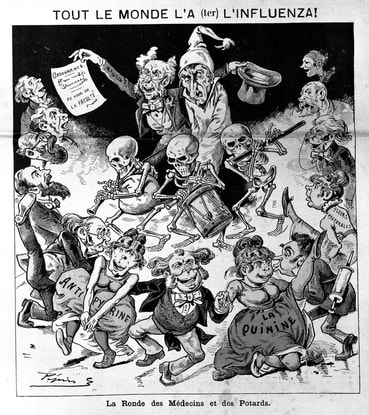 A man with influenza, taken in hand by a doctor, surrounded by dancing politicians. Wood engraving by Pépin (E. Guillaumin), 1889. A man with influenza, taken in hand by a doctor, surrounded by dancing politicians. Wood engraving by Pépin (E. Guillaumin), 1889. Sure, we've all heard about the Spanish Flu - or the Pandemic of 1918 - but what do you know about the Pandemic of 1889 - The Russian Flu? The 1918 outbreak coincided with the Great War and is now known to be an H1N1 virus that spread death across the world. But in 1889, at the height of the Belle Epoque, virology was unheard of. Some scientist now believe the 1889 Flu was the first COVID-19 outbreak. Peculiar observations made during the Russian flu pandemic included the loss of smell and taste not caused by nasal congestion. These and other observations documented in the historical records point more to COVID-19 than to an influenza-like disease. The long recovery period and the frequent neurological sequels mentioned in case reports and following years of fatigue, lack of concentration, depression and anxiety also resemble what is now described as "long haulers or long covid" symptoms. Of particular note is the frequent mentioning of persistent headaches weeks and even months after the acute infection, causing memory issues reported after the 1889 pandemic and now after COVID-19, while such reports are not prevalent after the Spanish flu influenza. And the Russian flu outbreak occurs exactly when EJ, Daisy and Endie Polk were visiting the Exposition Universelle in Paris for the opening of the Eiffel Tower, and then in Milan studying at the Milan Conservatory. Here is an excerpt from the Chapter "Potions, Puccini & Pandemics";
The final bit of this biological tale concerns the history of conspiracy theories. An article in a December 1889 edition of The New York Times reported that the flu was mostly harmless. “There is nothing fatal about the universal cold”. Papers around the world also promoted "remedies" of quinine, an antimalarial drug that is the antecedent of chloroquine and hydroxychloroquine. Dr.'s warned against these, but their warnings were unheeded. There were theories that it was caused by electrification of cities, or from telegraph poles. One Dr. in Chicago with dubious credentials claimed the source was stardust passing through the Earth’s atmosphere. Still other physicians soberly rejected this idea for other causes such as volcanic dust or bird migrations. Migration of a kind was surely to blame for the speed and breadth of the spread. 1889 to 1890 marked the largest number of people traveling between continents and the highest record transatlantic ship travel in the history of the world to that date. Everyone was heading to Paris for the great exposition and then back home. In the end, the 1889 pandemic killed one million people out of a worldwide population of about one and a half billion. It was the last great pandemic of the 19th century, and is among the deadliest pandemics in history with recurrent outbreaks through early 1895. Citation: Brüssow, Harald, Brüssow, Lutz; "Clinical evidence that the pandemic from 1889 to 1891 commonly called the Russian flu might have been an earlier coronavirus pandemic." Microbial Biotechnology Journal. https://doi.org/10.1111/1751-7915.1388
Image: http://wellcomeimages.org/indexplus/obf_images/cf/85/07e5093703d1a44724afcc4ec11d.jpg
0 Comments
Your comment will be posted after it is approved.
Leave a Reply. |
Some stories that couldn't make the book in full ... but need to be told! Editors welcomed - sign up below.
STORIES
WR HEARST PLANS SONG: DAISY HOT SPRINGS 1882 A WILLIS POLK GIFT THE RLS CONNECTION 1896 EARTHQUAKE TALES FROM COPPA PANDEMIC OF 1889 THE BOMB THAT SHOOK SF MILAN:CITY OF WATER POLK ON THE MAP FEATHERS, FASHION & FLY FISHING RARE AVIATION FILM - WWI 1914-17 1906 SAN FRANCISCO WTF FILES - TECHNOLOGICAL GET ME OUTTA HERE! NO HORSES, NO TENTS, NO $ DAISY IN FRENCH LITERATURE DAISY ON FILM! THE WHITE DEATH THE SYMBOLISM OF FLOWERS POSTE DE SECOURS WWI TRAVEL 1900: LONDON TO PARIS DAISY: REST IN PEACE KEITH'S, DRANE'S & KENTUCKY MOTHER: MISSOURI COMPROMISE Topics
All
|

 RSS Feed
RSS Feed